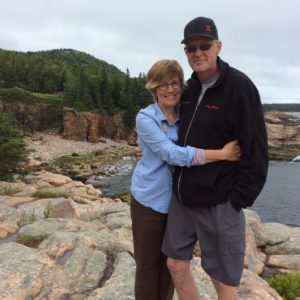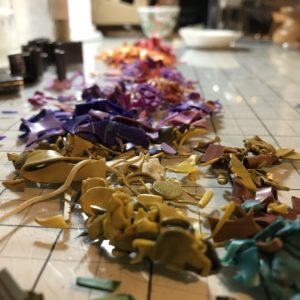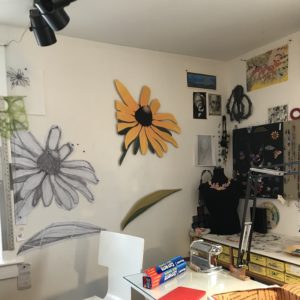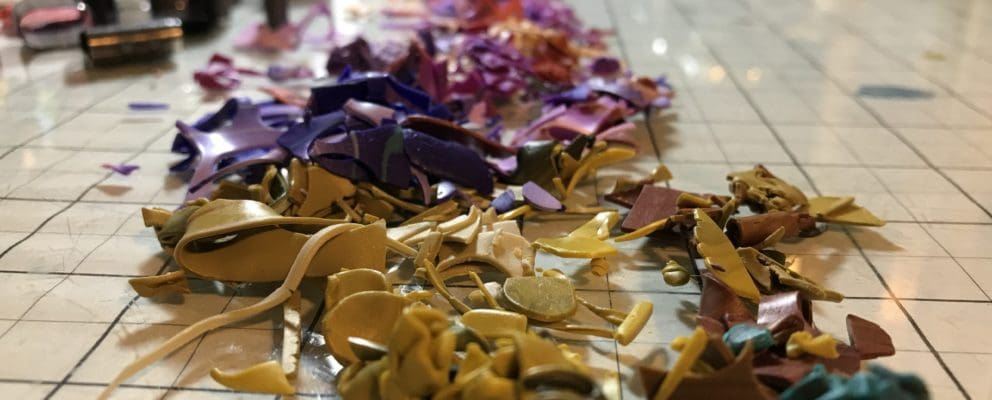
When we asked Bonnie to write a blog post weeks ago, we wanted an experienced artist to tell their stories and share their thoughts on what it takes to show at CraftBoston for over a decade.
What we didn’t see coming was that we would have to cancel CraftBoston Spring 2020 and that the entire craft community would be turned upside-down by the coronavirus pandemic. Now more than ever, we all need each other in order to keep ourselves steady in such rough waters. As I work from home, I look around at all the artworks and objects that make my house my sanctuary, and I am more grateful than ever to the artists whose work brightens my days. Even at a distance, we are grateful to our craft community as we all go through this and we can’t wait to be together again on the other side of things.
While you are at home, please take the time to read Bonnie’s interview. It will bring you joy and might serve as a little light at the end of this tunnel.
Interview with Bonnie Bishoff, a mixed media artist partnered with J.M. Syron. Together they have made everything from furniture to jewelry, exploring materials and ideas along the way.
Well, things sure are different now than when you did the interview! Is there anything you would like to say to put your interview in context of current events?
We were exhibiting artists at CraftBoston Spring during the Marathon bombing. It was a shocking event and SAC closed down the show for one day. We did surely lose sales but this clearly paled in comparison to the fear and injury and grief experienced by the Boston community and beyond. I was glad that we still could go on with the show however , for those who chose to attend and for us as artists. Our presence was a clear message of hope, creativity and vitality. We need this to move forward and to keep our heads above water. I do believe that making art and being creative is an inherently hopeful act and we seek it out for that very reason as makers and viewers and collectors. It is an expression of the human spirit and I personally do not want to live in a world without it.

A little introduction on who you are and what work you make.
I have been working collaboratively with J.M.Syron, my husband, since 1987. We are partners in creativity and life. We started as furniture makers for about 20 years, specializing in studio furniture, furnishings and lighting with colorful veneers of polymer clay and carving. In the last 12 years we have slowly shifted to exploring jewelry and mixed media pieces. We work collaboratively in design and building. Our work primarily incorporates polymer clay, wood, wire and metal. We use millefiori techniques originating in the discipline of glass and marquetry techniques borrowed from woodworking to create highly detailed plastic veneers with the polymer clay. These polymer veneers creating exuberant surfaces that enrobe much of our work.
How long have you been doing CraftBoston?
We have been exhibiting in CraftBoston since its inception in 2002.

What keeps you coming back?
We’ve lived in New England for most of our time together and feel that CraftBoston and the Society of Art and Crafts have been a leading voice in the field of craft over this time. We want to be known by people in our locality and to be part of an annual event that highlights fine craft, allows attendees to meet artists, learn about their work, learn about different types of craft and the skill and imagination that goes into the work. The show creates a setting for people to revisit this idea, build connections to artists, learn more and collect.
How has your approach to craft shows changed over the years?
At first I imagined craft shows were places where we would be basically focused on selling lots of our work to eager collectors. After many years I realize now that a large portion of what this is about is education which leads to sales and collecting. It is my great hope that shows like CraftBoston continue to promote the vision of SA+C – that is to share the work of artists who have an extraordinary dedication to their craft and the quality of their skills and to expression and exploration in their work.
Do you have other ways to sell your work and how has that changed over the years?
We still primarily sell our work at a variety of craft shows and some galleries throughout the east coast. Over the years we have developed online sales through several catalogues and websites. We started out sending slides to jury for shows and waiting for acceptance packages to arrive in the mail !! Our website is still primarily a portfolio ….no shopping cart yet but soon come. However, I now really enjoy using Instagram to share our work and experiences – though I am still developing my voice in social media. As an obsessively visual person I especially enjoy following other artists on this platform, seeing what’s new, what inspires them and to peak into their studios. I feel my community of artists are more present daily as I work in my own studio and follow others as well.
What advice do you have for an artist who is just starting out?
Be patient. Be original. Don’t just develop a product. We don’t need more stuff – be a creative voice that takes us someplace new. Know that you are encouraging people to be curious and to be observant and hopeful about the human spirit. That is a process, not a one shot deal. Share your ideas and enthusiasm for your work with people who come in your booth because meeting and talking to you is part of what engages and builds long term customers and friendships.
What is the strangest thing that has happened to you on the floor?
Perhaps this isn’t strange but it was truly fun. In the early days of CraftBoston Holiday the event was held at the Cyclorama. It had a very cozy feel for holiday shopping. I loved how many customers were secretly shopping for someone who was attending the show with them. They would sneak back later and buy something from me. Numerous times I had to pretend like that a much desired item was not available and I became part of their delightful secret.


